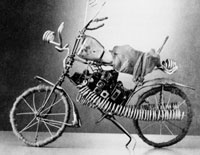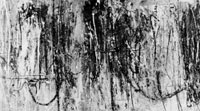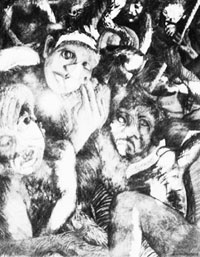A significant challenge to state policy as regards the visual arts was undertaken at The State of Art in South Africa Conference held in 1979 at the University of Cape Town. ParÂticipation from black artists at this conference was extremely small indicating the extent to which black artists had become isolated from the white academic institutions. A poem written by a participant at the conference captures the enormous gulf that existed between black and wh i te artists.
Report From The Art Conference In The Cape
by Masilo Rabothata
We were there blowing our lungs out to sharpen their appetites so they could gulp down the wine better and fill themselves of the cheese while they relaxed comfortably in their cosy park of intellectualism.
Never mind, we were there we belched our complaints aloud to them in lamenting song and crying verbatim we did not fail to create the desired mood.
No! not in the slightest did we not manage to arouse feelings that we also mattered that we want to play a part too in the running of our own land!
It's a shame, brother; as someone did say a disgusting shame I'd say that there still exists in some people such a big lump of naÁ¯veté and ignorant complacency
The rod and the bazooka shall not be spared And since we should, when we die, we will die! (1)
Out of this conference two important resolutions were passed. The first related to the need for increased educaÂtional opportunities for all artists and the second called for a boycott of all state sponsored exhibitions.
1. This Congress notes with serious concern the neglect of State support in the field of art education and training for all the people in South Africa. As a matter of urgency it requests all colleges and schools of art to be opened to all people in South Africa and that an effective system of bursaries accompany such legislation to enable the largest number of people to take advantage of such opportunity for art education.
2. This Congress notes that it is the responsibility of each artist to work as diligently as possible to effect change towards a post apartheid society. It urges artists to refuse participation in State sponsored exhibitions until such time as moves are made to implement the above-mentioned change.
The above resolutions were submitted in the names of Cecil Skotnes, Bill Ainslie and Andrew Verster. (2)
This was to have profound repercussions for government sponsored art and saw almost immediate effect in the boycott and cancellation of the 1980 Republic Festival Exhibition.
The promotion of art has become an arena of increasingly politicized activity. All exhibitions and training institutions are now viewed in relation to their sources of funding and the implicit political forces that underpin them.
The many issues and debates that surround the art of this century continue in the art of the 1980s: transitions between art and craft, images of township life and images of Africa, the impact of Christianity and the exploration of mysticism, the control of politics and the freedom of personal expression, the power of market forces and the resultant redefinition of art.
The 1980s are different to the extent that the market place has broadened and expanded, different kinds of materials are used, the range of imagery has been extended and the opportunity for formal training has increased. There has also been a reassessment and reaccommodation of functional objects within the fine art arena.
Academic researchers have become increasingly wary of the extremely limited definitions of art that arose out of the modernist era. A complete reappraisal of these definitions has resulted in a broader approach being taken. Museums and galleries, previously committed to a limited definition of fine art, are increasingly displaying a range of 'functional' objects, many of which were never intended to become objects of pure contemplation but were made to be used. Doe Molefe's painted postboxes, David Moteane's mixed-media motor bikes, Johannes Maswanganye's sangoma dolls: these and many other functional objects have been incorporated into collections of fine art. This reevaluation has been particularly evident as regards objects made by black artists. The same process has yet to be applied to the work of white artists.
 Moteane David (b.1951)
Moteane David (b.1951)
Wire motorbike
Art is being produced in many parts of the country and it displays a number of regional and individual styles, deriving from the many more 'centres' of artistic activity. All of these centres operate from distinct and increasingly interconnected impulses and educational programmes. They have taken from the inherited artistic traditions of Polly Street and Rorke's Drift as well as numerous other artistic traditions of Africa, Europe and America.
This list of art centres, and their founding dates, represents a significant new force in the field of black art education:
1972 Johannesburg Art Foundation, Johannesburg
1977 Katlehong Art Centre, Katlehong
1977 Community Arts Project (CAP), Cape Town
1978 Fuba Academy, Johannesburg
1979 Nyanga Arts Centre, Nyanga
1970s Mofolo Art Centre, Soweto
1983 African Institute of Art (AIA), Funda Centre, Soweto
1983 Community Arts Workshop (CAW), Durban
1986 Alexandra Arts Centre, Alexandra
Along with the many more black teachers training colleges, all of which participated in an exhibition of student work at the State Theatre, Pretoria in 1987, the total number of facilities appears to be increasing.
Whereas previous developments had tended to be dominated by work from one centre (from 1949-1962 it was Polly Street Art Centre, and from 1962 to the 1970s it was Rorke's Drift), there are now a number of community art centres and university art departments training artists. However the extent to which these new developments are able to influence the direction of South African art, or enhance the quality of black education, awaits evaluation.
There has been a far greater dialogue between artists working in South Africa and a more conscious cross-fertilization of ideas as well as practical workshops in which experiences are shared between artists. The Thupelo workshops, for example, which have taken place (1986-88) under the auspices of the Johannesburg Art Foundation, Fuba, the Alexandra Arts Centre and USSALEP have brought together many artists from various parts of the country. They have concentrated primarily on abstract approaches to painting and welded steel sculpture.
These workshops have received a fair amount of criticism, and are seen by many to be an imposition of an outmoded approach to painting. There has been the suggestion that black artists should only produce a figurative and committed art. (3) However the Thupelo workshops have provided invaluable insights into problems of painting, colour and expressive communication and most significantly have given many artists opportunities to experiment with new materials. The work of Bill Ainslie, Dumisani Mabaso, David Koloane, Pat Mautloa, and Garth Erasmus represent some examples of the work produced as a consequence of these workshops. Many other artists such as Avhashoni Mainganye and Helen Sebidi have derived a new facility with paint and colour from these workshops. Sebidi, who received art tuition from John Koenakeefe Mohl during the late 1970s, exemplifies the changes brought about through working in the Thupelo workshops and at the Johannesburg Art Foundation. The facilitating role of various community-based people and organizations has - to a certain degree - re-defined the established limits of patronage. The control of resources and the planning of projects have moved into the hands of black artists, educators and administrators.
 Mabaso Dumisani (b.1955)
Mabaso Dumisani (b.1955)
Untitled, 1986
Patronage has been extended beyond support for individual artists and into 'community structures'. The new 'community centres' and 'art centres' are supported by a number of patrons and sponsors: local and foreign governments, foreign church bodies, the corporate sector and trusts. This support has made it possible for artists to begin to explore non-commercial art forms.
 Sebidi Mmakgoba Helen (b.1943)
Sebidi Mmakgoba Helen (b.1943)
Mother Africa, 1988
The distribution and display of art has extended beyond the gallery and museum walls. Political posters (produced at CAP over the past decade), murals (greatly encouraged by the recent exhibition of Mural Art at the Market Galleries), and street art (in particular the work made in townships such as Mamelodi, Alexandra and Soweto in 1984) have all been produced in the black townships and have taken art into new social contexts. Whereas the art of the urban areas was previously only seen in galleries, churches, and private homes, it has begun to have a far wider impact through addressing the needs of the broader community. Two streams that are often set up to be in opposition to one another, that of fine art and ' community art ', inform an enormous amount of the educational debate within the field of art. The desire to imbue art with a useful function, be that economic, didactic or propagandistic, has resulted in discussions arising about concepts of accountability. In an unpublished article, Emile Maurice raises some of these issues.
In the western tradition, an artist is accountable to nobody but himself, as he is free to decide how and what to paint, whom to paint for, etc. By contrast, the community artist paints the concerns and aspirations of the community for the commuÂnity... Moreover, some community artists feel that the community "owns" their work, much in the way that a mask in traditional African culture belonged to the clan. (4) On the other hand the reluctance to face questions of accountability has caused artists to be viewed as outsiders and irrelevant to pressing and 'real' issues of existence. Bill Ainslie adds another dimension to this debate in the recognition that all people have within them the capacity for artistic expression.
We stand between the pole of "high art", which challenges all taste in its quest for the unconditioned act/work, and the pole of community - or grass roots - art which recognises that all people are capable of authentic and vital expres sion.(5)
A noticeable distinction within this art is that between self-taught and trained artists. The tradition of self-taught artists is most strongly represented by the new sculpture that has been produced in the 1980s.
Endnotes
1. M. Rabothata, "Report from the art conference in the Cape", Staffrider, vol. 2, no. 4, November/December 1979.
2. The state of art in Sout h Africa, conference proceedÂings, University of Cape Town, July 1979.
3. C. Smith, "Black artists: we're fed up with ' political ' labels", The Weekly Mail, 31 October 1986.
4. Tyrone Appollis, interview with Emile Maurice, SA National Gallery, 1988, p. 1.
5. The state of art in Sout h Africa, p. 80.